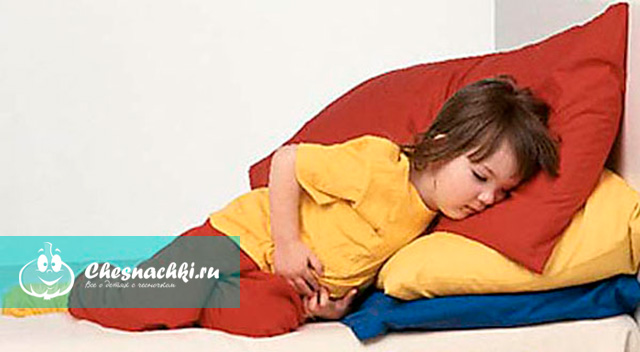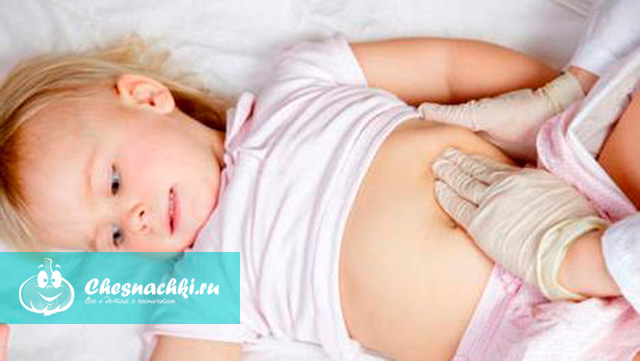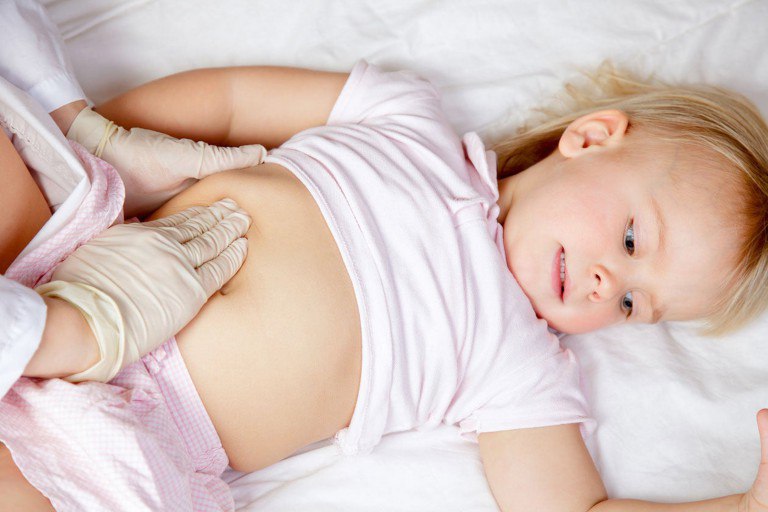The inflection of the gallbladder is a pathological condition in which the correct anatomical structure of the organ is disrupted and its function is reduced. The gallbladder is located on the lower surface of the liver and consists of three sections: the bottom, body and neck. Normally, it has the shape of a pear or funnel. The bend of the gallbladder is accompanied by its deformation and then it takes on a different shape.
Causes of inflection of the gallbladder
This pathological condition can be congenital or acquired.
- A congenital defect of the gallbladder is caused by defects prenatal development and genetic anomalies associated with impaired development of the muscular layer of the organ. This pathology does not require special treatment and is usually not manifested by clinical symptoms. Many people may not know that they have this defect, and the pathology is detected during an ultrasound scan. Also, congenital deformity of the gallbladder in children may resolve itself over time.
- Acquired inflection of the gallbladder is caused by the following causes: excessive activity, emotional and physical stress, eating disorders and obesity. Children should not lift heavy objects, because they develop organ prolapse, which also causes the development of the disease. This defect is manifested by undesirable symptoms and must be corrected.
Symptoms of an inflection of the gallbladder
The liver constantly produces bile, which serves as a solvent for food in the intestines. Bile is needed by the body for some time after eating, and not throughout the day. Therefore, the body needs its reservoir, which serves as gallbladder. It receives all the produced bile, and the gallbladder releases it into the intestines when necessary. Therefore, when it is deformed, there is a violation of the outflow of bile, which disrupts the digestive function. Symptoms of the disease depend on the location of the defect.
Inflection at the border of the bottom and body:
- Pain in the abdomen with spread to the collarbone, shoulder blade and sternum;
- Nausea and vomiting. The symptom occurs some time after eating;
- Formation of plaque in the tongue;
- The formation of jams and cracks in the corners of the mouth.
- This type of inflection is the most common in children.
Inflection of the neck of the gallbladder:
- Pain in the left hypochondrium;
- Nausea;
- Increased gas formation;
- Fever.
- Inflection of the cervix is a life-threatening condition that can cause bile to enter the abdominal cavity with the development of peritonitis.
Combined inflection
Very rarely, gallbladder deformity develops in several places. This is usually due to an increase in the organ or the formation of gallstones. Symptoms:
- Abdominal pain;
- Nausea after eating.
Consequences of inflection of the gallbladder
Uncorrectable acquired inflection of the gallbladder leads to:
- An increase in the liver with a violation of its function;
- development of jaundice;
- The development of chronic diseases of the stomach and intestines;
- Lag of the child in development.
Treatment of the inflection of the gallbladder
Treatment of the inflection of the gallbladder does not require surgery, but is limited only to conservative therapy. However, the fight against this pathology is a long process, which includes:
- Drug therapy. Choleretic drugs and antispasmodics are used to ensure that an excessive amount of bile does not accumulate in the lumen of the bladder, and it enters the intestine, performing a digestive function. Drug therapy is prescribed in several courses as prescribed by the attending physician;
- Physiotherapy. Physiotherapeutic procedures are prescribed to improve the blood supply to the gallbladder, restore its muscle activity and normalize the function performed;
- Spa treatment. There are special resorts for this pathology, visiting which will not only affect the function of the liver and gallbladder, but also strengthen the immune system;
- Antibiotics. Due to the deformation of the gallbladder, stagnation of bile develops. And the violation of the outflow is a favorable environment for the development of microorganisms. Therefore, against the background of pathology, infectious and inflammatory processes often develop, which are treated with antibiotics;
- Dieting. To some extent, this is the most important point in the treatment of inflection of the gallbladder. Indeed, without compliance proper diet the above appointments will not have a therapeutic effect.
Diet
- Categorically exclude fatty, fried, spicy and salty foods from the diet. Also, you should not give your child sweet confectionery and flour products.
- Include choleretic foods in your diet. Corn oil and pumpkin have a beneficial effect. The latter can be consumed baked and boiled, and it is also useful to drink a glass of pumpkin juice a day.
- Eat enough vegetables and fruits and drink plenty of water to avoid bile thickening.
Article prepared by Israel Cancer Center -
Does your child have a constriction (bend) of the gallbladder? Because of this deformation, the gallbladder does not work fully due to impaired outflow of bile. What to do in this situation? Let's look at the causes, symptoms, and treatments for gallbladder deformity in a child.
Many parents face deformation of the gallbladder (partial or complete). This pathology occurs in almost every fourth child aged 5-16 years. Normally, the gallbladder is pear-shaped. Due to some reasons, it may be deformed due to kinks in different places. The organ can take on a hook-shaped, arcuate or hourglass configuration. A double kink is also often found.
The main causes of gallbladder deformities are as follows:
- its increased mobility due to anatomical features;
- eating disorders - when your child eats at long intervals and overeats;
- sudden movements, jumping and lifting weights;
- excess body weight;
- sedentary lifestyle.
Bending of the gallbladder in a child: symptoms
You can suspect problems with the gallbladder and outflow of bile by the following signs:
- the child complains of pain in the abdomen (in the right hypochondrium);
- he is sick, maybe vomiting;
- there is bitterness in the mouth, bloating;
- temperatures may rise, etc.
As soon as you notice these symptoms, see your doctor. The bend of the gallbladder can be diagnosed by ultrasound.
The inflection of the gallbladder causes a normal outflow of bile. She stagnates. If the stagnation is prolonged, then an inflammatory process occurs.
The disease may not make itself felt for a long time. If it is detected, then it can proceed in two forms, which differ in symptoms. In the first case, your child may experience abdominal pain after eating fatty or fried foods. Abdominal pain can also occur due to excessive physical activity, fast walking, running. The second variant of the course of the disease is accompanied by long, aching pains in the region of the right hypochondrium. Your child may complain of bitterness in the mouth in the morning and nausea.
If, due to the deformation of the bladder, inflammation occurs and an infection joins, then your baby may have a fever.
What are the consequences of the bend of the gallbladder:
- indigestion due to incomplete breakdown and poor absorption of fats;
- the likelihood of obesity and the risk of diabetes;
- deficiency of fat-soluble vitamins (A, D, E and K);
- the occurrence of chronic cholecystitis;
- the risk of gallstone disease.
Gallbladder deformity is enough dangerous disease. With such a pathology, there is a high risk of necrosis of a part of the organ, which can provoke bile into the abdominal cavity and peritonitis.
Inflection of the gallbladder in a child: treatment
Once your child is diagnosed with an inflection of the gallbladder, the doctor will prescribe treatment. As a rule, it is conservative and its purpose is to establish an outflow of bile. Treatment includes the following methods:
- a diet that excludes the use of fried, fatty, spicy, sour;
- for the period of exacerbation - a special diet, taking choleretic drugs, antispasmodics and painkillers;
- in case of inflammation, antibiotics are prescribed;
- phytotherapy;
- physiotherapy.
Good afternoon, dear readers!
Have you encountered such a phenomenon as the bending of the gallbladder in a child, the symptoms and treatment of which are very difficult?
The disease is quite rare, but if your baby often complains of pain in the collarbone, he has vomiting, nausea, you should be aware of it. What is an inflection of the gallbladder?
To imagine how a disease occurs, you need to imagine what the gallbladder consists of. It has three components:
- neck;
- body.
Normally, when the bubble is filled, it becomes pear-shaped. With deformation and inflection, the shape of the organ changes, and its functionality is impaired.
Inflection can occur as a congenital disease, and it often disappears on its own. childhood or is asymptomatic. The causes of occurrence lie in genetic characteristics or adverse factors of intrauterine development.
If the disease was acquired in childhood, the treatment will be difficult and long. The causes of the disease can be:
- prolonged stress;
- obesity;
- excessive movement;
- malnutrition;
- heavy physical labor;
- chronic diseases of the pancreas.
If a child has cholelithiasis, he may also be threatened by an inflection of the bladder. In this case, you need to carefully monitor the symptoms of the disease.
signs
The bend of the gallbladder in the older child and the baby is expressed by similar signs. True, it is much more difficult to find out what is bothering the baby than in the case of a child from 2 years old.
An inflection of the organ is possible if the baby complains of such conditions:
- pain in the side, back, shoulder blades;
- if bile enters the peritoneum, it can be felt pain in a stomach;
- bloating, cramps in the intestines;
- sudden changes in body temperature;
- stool problems, constipation.

The symptoms are quite obvious and sometimes leave no doubt. By the nature of the pain, you can even determine which section of the gallbladder is twisted:
- If the problem is localized at the junction of the bottom and body of the organ, pain will be felt in the peritoneum, sternum, nausea and vomiting are recorded. A plaque appears on the tongue, and seizures appear in the corners of the mouth.
- If the cervical region of the organ suffers, pain is felt on the left under the ribs, nausea and flatulence occur. The consequences of the inflection of the cervical region are especially dangerous: bile can enter the peritoneum and cause peritonitis.
- With a combined form of bending, pain is felt in the peritoneum, accompanied by a lack of appetite, vomiting and nausea.
It is not worth waiting until everything goes away on its own, especially if the disease causes discomfort to the child. You should call a doctor and seek medical attention.
What is dangerous?
A great danger is the acquired inflection that has arisen in a baby with age. The consequences if left untreated are far from pleasant:
- liver enlargement;
- jaundice;
- chronic diseases of the gastrointestinal tract;
- developmental disorder.

The long-term consequences can be even worse. Gradually bile, finding no way out, will accumulate in the body. Lipids from food are not completely broken down, a large amount of fatty acids accumulate in the blood. As a reaction to the process, the rate of glucose oxidation decreases.
What follows, readers, I think, have guessed: diabetes and obesity, since fats will not be absorbed, and there are not enough vitamins to dissolve fats.
At the next stage, vision, muscles, and blood vessels will suffer. If there is no treatment, cholecystitis and cholelithiasis develop.
So the question of treatment should not be faced by parents: you need to see a doctor and examine the baby.
Diagnosis and treatment
The main way to diagnose the disease, of course, is ultrasound. If a kink is present, it will be clearly visible on the screen.

To confirm suspicions, you can take additional tests:
- x-ray of the liver;
- x-ray of the biliary tract;
- Ultrasound of the biliary tract.
Analyzes are necessary because along with the bending there may be biliary dyskinesia.
A hepatologist and a gastroenterologist deal with gallbladder problems. During treatment, the following drugs are prescribed:
- Flamin is a choleretic agent based on immortelle (prescribed for children from 3 years old).
- Odeston is a choleretic agent, relieves spasms.
- Aristochol is a drug based on natural ingredients. It has a laxative effect, relieves spasms well.
- Hofitol is a drug based on artichoke leaf extract. Allowed for children from 6 years old. It has a hepatoprotective and choleretic effect.
- Tsikvalon is a choleretic agent.
Treatment with medicines can be accompanied by herbal therapy. For this, choleretic collection No. 3 is used, which includes:
- chamomile;
- calendula;
- tansy;
- mint;
- yarrow.

It is necessary to prepare the infusion in a water bath, for which 2 tablespoons of raw materials are taken. Boil in a water bath for a quarter of an hour. The resulting broth is diluted with boiled water to a volume of 200 ml. The remedy should be drunk per day for a third of a glass three times a day.
With an inflection of the bile, a special diet is indicated. Need to exclude:
- spicy, fried and fatty;
- canned food;
- legumes;
- whole grain foods;
- spices;
- carbonated drinks;
- dried fruits, sweet fruits (grapes).
Dr. Komarovsky in his program explains in detail how dependent the course of the disease is on proper nutrition. With biliary dyskinesia, you should not force the baby to eat: he must want to!
With qualified treatment, the prognosis is favorable. The most important thing in treatment is to ensure the outflow of bile. If this process is absent, the bubble is removed surgically.
The key to successful treatment is a combination of proper nutrition, feasible physical exercise, and well-prescribed drugs. Only in this case the health of the child is guaranteed.
The gallbladder is a small organ located on the surface of the liver. It consists of a bottom, body and neck, smoothly passing into each other. The neck is turned back and up, and the cystic duct departs from it. In children, the shape of this organ changes as they grow older.
But it is precisely because of its mobility that such a phenomenon as an inflection of the gallbladder in a child can occur. Acquiring a variety of configurations, the bubble can bend in different places, or even in several at the same time.
However, do not panic if your baby has been diagnosed with this. The disease is incredibly common and effectively treated by modern medicine. Moreover, the disease is not included in the category of pathological, but is just a feature of the structure of the organ.
That is why the disease does not require global changes in life, special treatment, and even more so surgical intervention. The bend may eventually disappear on its own, and a set of simple measures will help accelerate positive changes.
Probable causes of the disease
Experts identify the following most common factors that provoke an inflection of the gallbladder in children:
- congenital condition. The defect can occur from the very moment of birth or immediately after childbirth. A variant of a genetic predisposition to this disease has not been established, but such a possibility is also not excluded;
- features of physiological development. Often, the defect manifests itself in hyperactive babies or, on the contrary, excessively clamped and prone to frequent stress;
- wrong diet. The factor of violation in the diet today is the most common. Modern parents often follow the lead of children, buying them sweets and carbonated drinks, which does not have the best effect on the state of the gallbladder and liver.
Symptoms of an inflection of the gallbladder
There are three main types of inflection, depending on which one or another clinical manifestation can be observed.
So, the inflection between the bottom and the body of the gallbladder, which is the most common type, causes such manifestations:
- pain radiating to the right side;
- nausea and vomiting;
In this form, children may experience loose stools and may need additional treatment for diarrhea.
In the inflammatory form of this type, the symptoms are supplemented by such manifestations:
- increased sweating;
- bitter taste in the mouth;
- earthy complexion.
The inflection of the neck of the gallbladder is characterized by elongation of the neck of the organ or sagging of the body. This defect can have consequences in the form of necrosis of the neck, which can lead to bile entering directly into the abdominal cavity.
When the neck is bent, the symptoms may be as follows:

- the child has a stomach ache or the region of the left hypochondrium;
- bloating;
- nausea;
- increase in body temperature;
If inflammatory processes are present in the body, the same symptoms can be observed as in the previous case.
Twisting of the gallbladder in several places is a fairly rare pathology.
Among the causative factors of this disease may be the increased size of the organ itself or the presence of stones in it. Symptoms include intermittent pain and nausea.
Very often, the defect is congenital and can be completely asymptomatic until it becomes visible on ultrasound. If the pathology is acquired due to any factors, it is subject to treatment.
What are the consequences of a ruptured gallbladder?
The organ serves as a storage for bile, which is produced by the liver. Bile accumulates in the bladder, and at the time of transit of food into the duodenum, it enters the sections of the intestinal tract. When the bladder is bent, there is a violation of the outflow of bile and its stagnation. A long period of such stagnation can lead to increased activity of microorganisms, after which the appearance of inflammatory processes that cause pain in the abdomen is likely.
Treatment of the inflection of the gallbladder
The complex of medical procedures for the acquired type of disease, as a rule, includes the following:
- choleretic drugs;
- adherence to a special diet;
- during periods of exacerbation, physiotherapy is used, but physiotherapy exercises are more suitable for children;
- the use of natural products from corn, in particular corn oil, which has excellent choleretic properties;
- folk methods are appropriate if they are agreed with the attending physician;
- antibiotic treatment is necessary in case of development of infectious and inflammatory processes;
- sanatorium treatment includes a whole range of measures to eliminate the consequences of this pathology.
As a rule, the treatment of the bend is limited to the indicated methods. Cases of surgical intervention in the inflection of the gallbladder are extremely rare. Hereditary deformity of the gallbladder usually resolves on its own and does not require any treatment.
Features of dietary nutrition
One of the most important components of the treatment of bending is diet.
The following foods should be excluded from the child's diet:

- fatty varieties of meat and fish;
- fried, spicy and too salty dishes;
- confectionery, especially those containing margarine;
- chips and other snacks.
Include as many fruits and vegetables in your child's diet as possible. Especially useful product it may turn out to be a pumpkin, which, when boiled, is an excellent choleretic agent. Make sure that the baby drinks enough water - this helps to avoid thickening of the bile.
Do not forget about fermented milk products, preferring low-fat kefir or yogurt. It is desirable that the food be fractional. It is optimal if the child eats six times a day in small portions.
